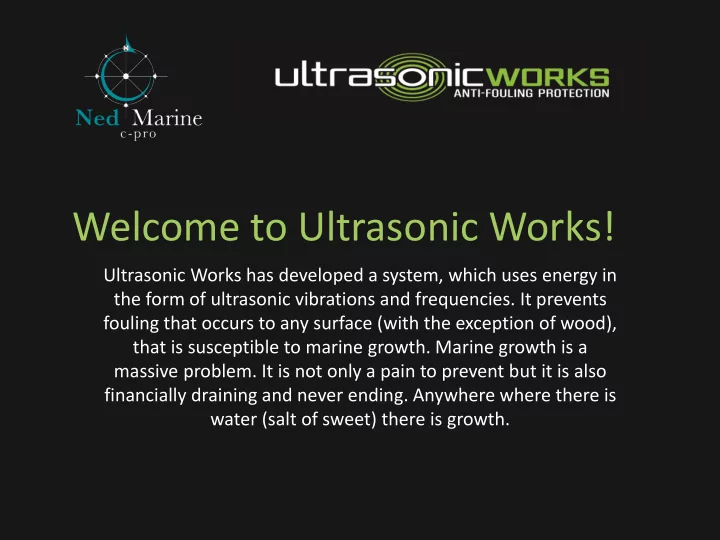

Welcome to Ultrasonic Works! Ultrasonic Works has developed a system, which uses energy in the form of ultrasonic vibrations and frequencies. It prevents fouling that occurs to any surface (with the exception of wood), that is susceptible to marine growth. Marine growth is a massive problem. It is not only a pain to prevent but it is also financially draining and never ending. Anywhere where there is water (salt of sweet) there is growth.
What is Ultrasonic Antifouling? • The use of Ultrasonic technology: – to send small sonic vibrations. – at frequency above human hearing. – that is disruptive to the bio film, – which in turn stops fouling. • Discovered in the 1930′s by French scientist Paul Langevin
How does it work? • Periodically with a sweep of ultrasonic frequencies. • Vibrate the organelle of the larvae and algae causing them to become damaged or fail. • Unable to produce the energy needed to survive, making them unable to colonize.
Advantages of using Ultrasonic Antifouling • 1st viable alternative to high current 300A anode Copper & Silver Ionization / Cathodic Systems. • Environmentally friendly • Fuel savings • Easy installation • Requires low maintenance • Low docking costs • No interferences • Great return on investment • Lower temperatures
Our system • Tailor made installation. • Design & build option. • Extra resiliency & redundancy via “salt & peppering”. • Transducer heads are inter woven with each other. • Designed for greatest levels of resiliency. • Marine grade anodized aluminum transducer housing. • Dual frequency transducer
Technical data • Transducer dimensions – 80mm x 200mm • Control panel – 1 CP for box coolers (2 systems) - 2 CP for hull (total 4 systems) - 1000mm x 600mm x 400mm - LCD monitoring screen • Real time monitoring - cat 5 cable from CP to ships internet • Software updates sent externally to CP using internet • Power – anywhere between 110-250 volts • Usage – approx 60 watts per transducer
Installation • Does not require piercing the outer skin of the hull. • Bonded to the internal hull with 2-part resin. • No wielding or cutting of the hull. • Cleanest & lowest risk installation. • Installation can be done anywhere.
Summary • Made bespoke for our clients. • Once layouts and plans have been received, our technicians will analyze and revert back with the best locations for the transducers. • Inter-woven to ensure complete coverage of the target area. • Connected to the control panel. • Expected lifespan = 10 years. • Maintenance contracts available. • Monitored from head office. • Updates of new software. • 24/7 helpline.
Testing box cooler
Ideal transducer locations
Example box cooler locations
Recommend
More recommend